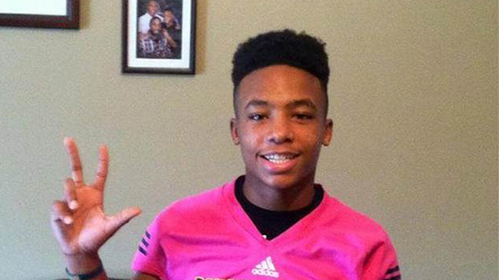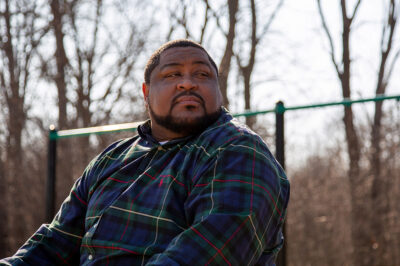
The olive branch is universally recognized as a token of peace. In Mississippi’s DeSoto County however, Olive Branch’s high school embodies zero tolerance at its worst.
Dontadrian Bruce, a student at Olive Branch High School, didn’t know what to expect when he was summoned to the assistant principal’s office on a Monday morning last February. He was surprised when Assistant Principal Todd Nichols pointed to a photo of the 15-year-old posing with his classmates in front of their biology project — a model of the DNA molecule built with Lego blocks — and said, “This is a gang sign. You’re a gang banger.”
In the photo, Dontadrian, intending to represent his number on the school’s football team, was holding up his thumb, forefinger and middle finger. That innocent body language, according to Nichols, was sure-fire evidence of affiliation with the Vice Lords, a Chicago-based gang that has a strong presence in Memphis, Tenn., 20 miles northwest of Olive Branch.
“I said, ‘I’m not in a gang,’ but he said, ‘Yes, you are. You’re a gang banger,'” Dontadrian recalls. Over his vigorous protestations, Dontadrian was suspended for gang activity.
His mother, Janet Hightower, was shocked when she got a call telling her to pick up her son. “He’d never been in trouble at school,” she says. “He’s a good, respectful young man.”

Three days later, Dontadrian appeared before a disciplinary hearing, where a school-delegated “gang specialist” presented a photo of a Vice Lords member making a gesture similar to Dontadrian’s — proof, he said, that Dontadrian had indeed flashed a gang sign.
Hightower questioned the specialist’s assertion. She had Googled images of gang signs and found only one photo of a sign resembling the one Dontadrian had made. It was the exact same photo offered by the gang specialist as irrefutable proof of gang activity. “He claimed my son was in a gang, but the only evidence he had was that one photo.”
She was further dismayed by the school administration’s failure to conduct a thorough inquiry before suspending Dontadrian. “They didn’t look at his academic and disciplinary record before suspending him,” she says. They never asked his teachers, his coach or his friends if he was in a gang. They should have investigated first, had a conversation with the people who know him.”
Despite little concrete evidence beyond conjecture, the disciplinary hearing officer suspended Dontadrian for the remaining five months of the school year and recommended expulsion.
“Because I’m Black”
According to the school administration, the action was taken because Olive Branch High School is guided by a “zero-tolerance” policy regarding gang activity. But Hightower and her son take a different view.
“When he talks about what happened and why, he says, ‘They think I’m in a gang because I’m Black,'” she said.
Hightower is less certain that race was the predominant factor in Dontadrian’s excessive punishment, but thinks it may have played a part. “I love Olive Branch, and I love the way they teach,” she says. “But I’m not going to say there aren’t any prejudiced people in the schools here.”
She contends that the school and district administrators are predisposed to overreaction, and that the application of zero-tolerance policies is inconsistent at best. This was underscored by the school’s decision to suspend Dontadrian’s older brother, Dontavis, who in an act of solidarity posed with a group of classmates for a photo in which they all held up the incriminatory hand gesture. In all, 10 students posed for the photo, yet only Dontavis was suspended.
“They suspended him for three days, but not the other kids,” she says. “They all made the same sign. Why single out Dontavis?”
Disproportionate Discipline
Olive Branch High School is just the latest DeSoto County school to expel a student for gang involvement based on little or no evidence. In 2009, the ACLU sued the district on behalf of a student at Southaven Middle School who was expelled after authorities illegally searched his cell phone and found photos that they claimed depicted “gang-related activity.” In actuality, the photos depicted the student dancing in the bathroom of his own home.
Moreover, the district has a record of disproportionately disciplining students of color. In 2011 (the last year data was available), student enrollment was 60.4 percent white, 31.8 percent Black, and 6 percent Hispanic — yet Black and Hispanic students who were suspended totaled 58.8 percent.
Such disparities are hardly confined to DeSoto County, however. Nationally, according to recent data released by the U.S. Department of Education (DOE) Civil Rights Data Collection, “Black students are suspended and expelled at a rate three times greater than white students.”
Harsh disciplinary policies have far-reaching impact on the educational development of the students affected, often resulting in lower school achievement and a spiral that singles out and criminalizes children who would otherwise be on a different path. This spiral, known as the school-to-prison pipeline, is delineated in the DOE guiding principles for improving school climate and discipline, issued in January 2014:
Suspended students are less likely to graduate on time and more likely to be suspended again, repeat a grade, drop out of school, and become involved in the juvenile justice system.
Determined to keep her son from entering a similar cycle of suspension, expulsion, or worse, Janet Hightower shrewdly enlisted local media in the effort to reverse the school’s decision. After several area news reports on the incident aired, Dontadrian was permitted to return to school 21 days after his suspension.
“I don’t think the school wanted the media attention,” Hightower says. “They knew I wasn’t going to back out or back down until their decision was overturned.”
Dontadrian’s return, however, came with a caveat: Hightower would have to agree to a one-year probation for her son. She refused.
“It would have been like saying my son was guilty,” she explains. “Besides, it didn’t make sense with their policy. Either he was guilty and should be expelled, or he was innocent and should be allowed back. Period.”
Following a series of discussions between Hightower and Olive Branch’s principal, the school finally backed down and removed the conditions from Dontadrian’s return.
Hightower’s advice to parents whose children are in a similar position: “If you think your child is innocent, fight back. Do whatever it takes.”
“It Could Happen to Anyone’s Child”
Dontadrian’s suspension is behind him, but not its ramifications. The A and B student has struggled to catch up with his classmates, and brought home two F’s in his third-quarter report card at the end of March.
“He’s having a hard time,” says his mother. “This is the first time he’s ever had an F. It’s really taking a toll on him trying to catch up on everything.”
For Dontadrian, hard work, determination, and his family’s support may well keep him out of the school-to-prison pipeline. But given the reality that children of color and children with disabilities are unduly affected by school disciplinary policies, how do other students avoid becoming statistics? The DOE guiding principles offer a solution:
[s]chools should provide professional development and training to equip educators to […] respond to student misconduct fairly, equitably, and without regard to a student’s personal characteristics (e.g., race, color, national origin, religion, disability, ethnicity, sex, gender, gender identity, sexual orientation, or status as an English language learner, migrant, or homeless student).
Meanwhile, Dontadrian’s expulsion has turned Hightower into a vocal opponent of zero-tolerance policies, and school-to-prison pipeline issues in general. She currently is working with the ACLU’s Mississippi affiliate to bring about a change in school policy that she hopes will prevent future incidents for all children in the DeSoto County School District.
“It happened to my son,” she says. “If it doesn’t get fixed, it could happen to anyone’s child.”


